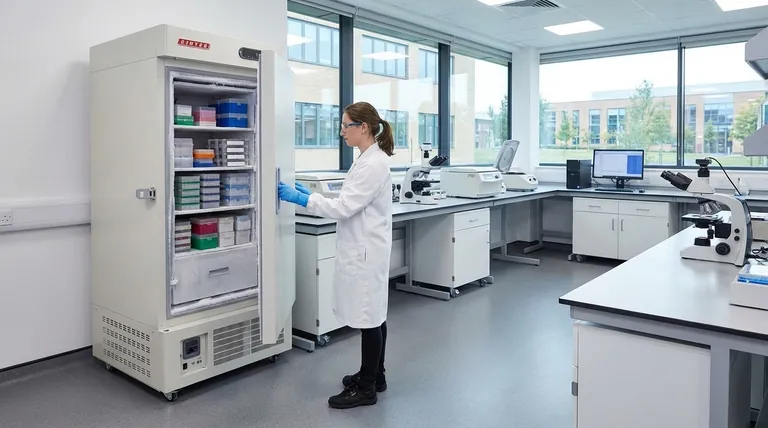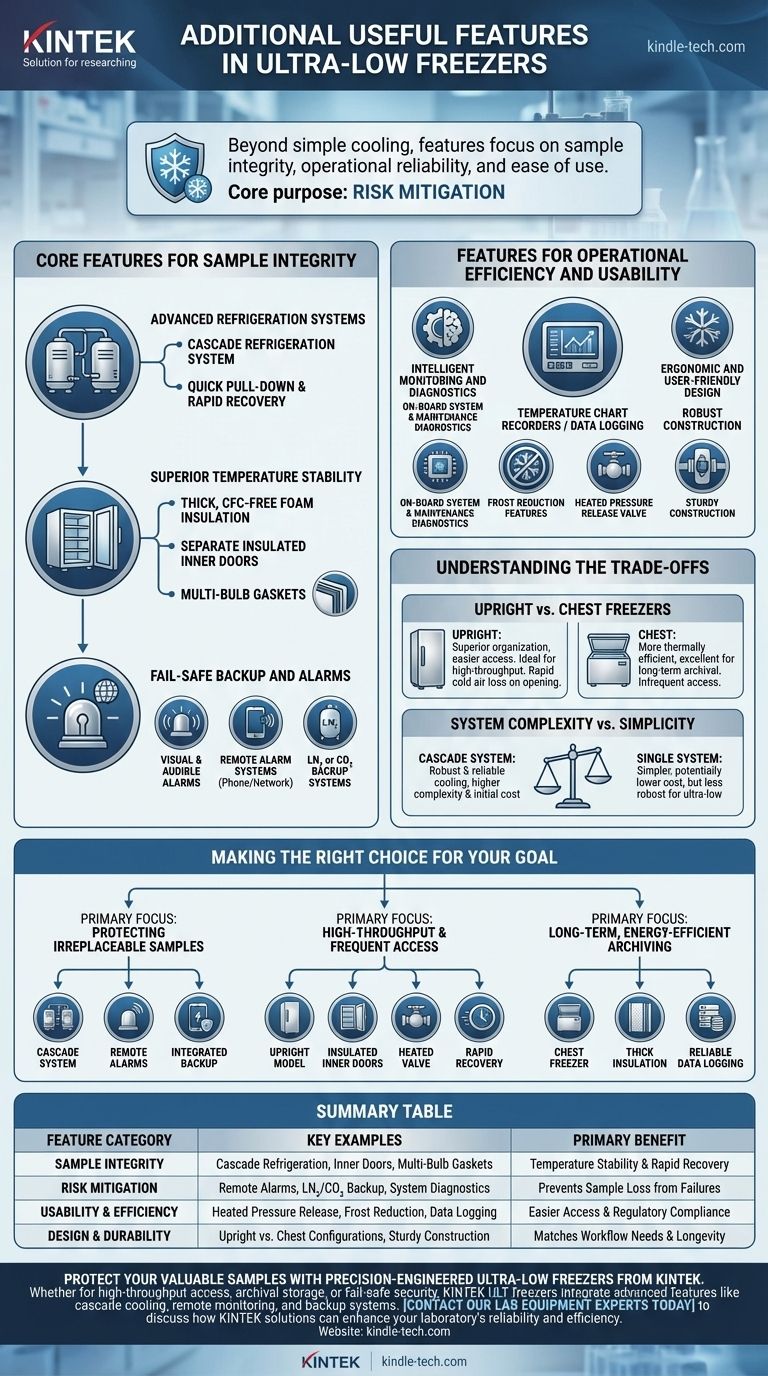Beyond simple cooling, the most useful features in an ultra-low freezer focus on ensuring sample integrity, operational reliability, and ease of use. These include on-board system diagnostics, multi-bulb gaskets and insulated inner doors for temperature stability, and critical add-ons like remote alarm systems and CO₂ or LN₂ backup systems for ultimate sample protection.
The core purpose of any advanced freezer feature is not technological novelty, but risk mitigation. The best features work in concert to protect valuable samples from temperature fluctuations, equipment failure, and human error.

Core Features for Sample Integrity
The primary function of a ULT freezer is to preserve samples. The following features are critical for ensuring that stability over the long term, especially in the event of an external disruption.
Advanced Refrigeration Systems
Most modern ULT freezers use a cascade refrigeration system. This involves two separate cooling circuits working together to efficiently reach and maintain ultra-low temperatures, typically down to -86°C.
This design enables quick temperature pull-down when the unit is first started and, more importantly, rapid recovery of the set temperature after a door has been opened.
Superior Temperature Stability
Even minor temperature fluctuations can compromise sensitive biological samples. Thick, CFC-free foam insulation is the first line of defense against ambient temperature changes.
To combat temperature loss during access, high-end models feature separate internal storage compartments with their own insulated doors. This prevents the entire freezer's air mass from being exposed when you only need to access one section.
Finally, multi-bulb gaskets around the main door create a superior seal, minimizing cold air leakage and preventing frost buildup that can compromise the seal over time.
Fail-Safe Backup and Alarms
The most significant risk is freezer failure. Visual and audible alarms are standard, but they are only effective if someone is present to hear them.
For this reason, remote alarm systems that can alert staff via phone dialers or network notifications are essential. These systems provide immediate warning of a temperature deviation or power failure, allowing for rapid intervention.
For ultimate sample security, backup systems using liquid nitrogen (LN₂) or carbon dioxide (CO₂) can be integrated. These systems automatically engage if the primary cooling system fails, keeping the chamber at a safe temperature for hours or even days.
Features for Operational Efficiency and Usability
A freezer must be effective, but it must also integrate seamlessly into a laboratory's workflow. These features focus on long-term reliability and ease of daily use.
Intelligent Monitoring and Diagnostics
Modern freezers include on-board system and maintenance diagnostics. This allows the unit to monitor its own health, alerting users to potential issues with compressors or fans before a catastrophic failure occurs.
Temperature chart recorders or digital data logging are also crucial for quality control and regulatory compliance, providing a continuous, verifiable record of the freezer's temperature history.
Ergonomic and User-Friendly Design
Frequent frost buildup is a common problem that can jam drawers and compromise door seals. Features designed to reduce frost formation are a significant quality-of-life improvement.
A heated pressure release valve is another key ergonomic feature. It prevents the vacuum that forms after closing the door from sealing it shut, allowing for immediate re-entry when needed.
Robust Construction
The physical durability of a freezer is paramount for long-term reliability. Sturdy construction, including heavy-duty door handles and latches, ensures the unit can withstand constant use in a busy lab environment, reducing maintenance needs.
Understanding the Trade-offs
Choosing a freezer involves balancing competing priorities. Understanding the inherent trade-offs in design is key to making an informed decision.
Upright vs. Chest Freezers
Upright freezers offer superior organization and easier access to samples, making them ideal for high-throughput labs where items are frequently retrieved. However, they lose cold air more rapidly when the door is opened.
Chest freezers are more thermally efficient because cold air, being denser, tends to stay inside when the lid is lifted. This makes them an excellent choice for long-term, archival storage where access is infrequent.
System Complexity vs. Simplicity
While a cascade compressor system offers robust and reliable cooling for the ultra-low range, it is inherently more complex than a single-compressor system. This can mean higher initial costs and potentially more complex maintenance down the line.
Making the Right Choice for Your Goal
Selecting the right features depends entirely on your laboratory's primary objective and workflow.
- If your primary focus is protecting irreplaceable samples: Prioritize a robust cascade refrigeration system, comprehensive remote alarms, and an integrated LN₂ or CO₂ backup system.
- If your primary focus is high-throughput and frequent access: Look for an upright model with insulated inner doors, a heated pressure release valve, and rapid temperature recovery performance.
- If your primary focus is long-term, energy-efficient archiving: A chest freezer with thick insulation and reliable data logging for temperature monitoring is likely the most suitable choice.
Ultimately, choosing the right features is about aligning the freezer's capabilities with the specific demands of your work to ensure both sample safety and operational excellence.
Summary Table:
| Feature Category | Key Examples | Primary Benefit |
|---|---|---|
| Sample Integrity | Cascade Refrigeration, Inner Doors, Multi-Bulb Gaskets | Temperature Stability & Rapid Recovery |
| Risk Mitigation | Remote Alarms, LN₂/CO₂ Backup, System Diagnostics | Prevents Sample Loss from Failures |
| Usability & Efficiency | Heated Pressure Release, Frost Reduction, Data Logging | Easier Access & Regulatory Compliance |
| Design & Durability | Upright vs. Chest Configurations, Sturdy Construction | Matches Workflow Needs & Longevity |
Protect your valuable samples with precision-engineered ultra-low freezers from KINTEK.
Whether your lab requires high-throughput access, long-term archival storage, or fail-safe sample security, our ULT freezers integrate advanced features like cascade cooling, remote monitoring, and backup systems to meet your exact needs.
Contact our lab equipment experts today to discuss how KINTEK solutions can enhance your laboratory's reliability and efficiency.
Visual Guide

Related Products
- 108L Vertical Ultra Low Temperature ULT Freezer
- 408L Advanced Vertical Laboratory Ultra Low Temperature Freezer for Critical Research Material Preservation
- 308L Precision Ultra Low Temperature Freezer for Laboratory Applications
- 608L Essential Laboratory Ultra Low Temperature Freezer For Critical Sample Preservation
- 708L Ultra Low Temperature Freezer High Performance Laboratory Freezer
People Also Ask
- What factors should be considered when selecting an ultra-low temperature freezer? Ensure Sample Integrity and Long-Term Value
- What makes Ultra-Low Temperature freezers energy efficient? Key Design & Operational Strategies
- In what fields are ultra low temperature freezers most commonly used? Essential for Biomedical, Clinical, and Research Labs
- Where are ultra low temperature freezers commonly used? Essential for Labs, Hospitals, and Biotech
- What are the common applications of ultra-low temperature freezers? Preserve Your Most Valuable Samples



















